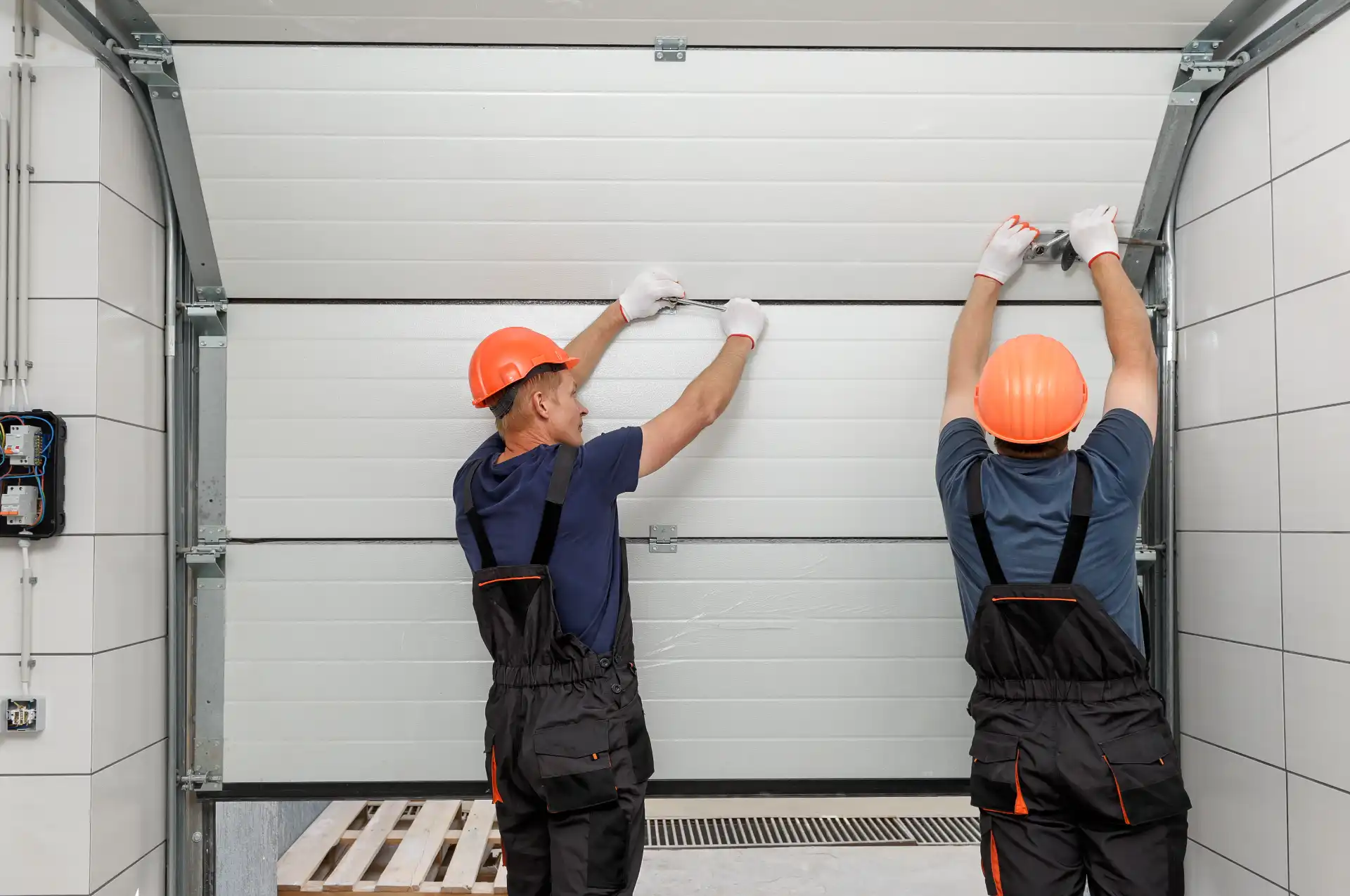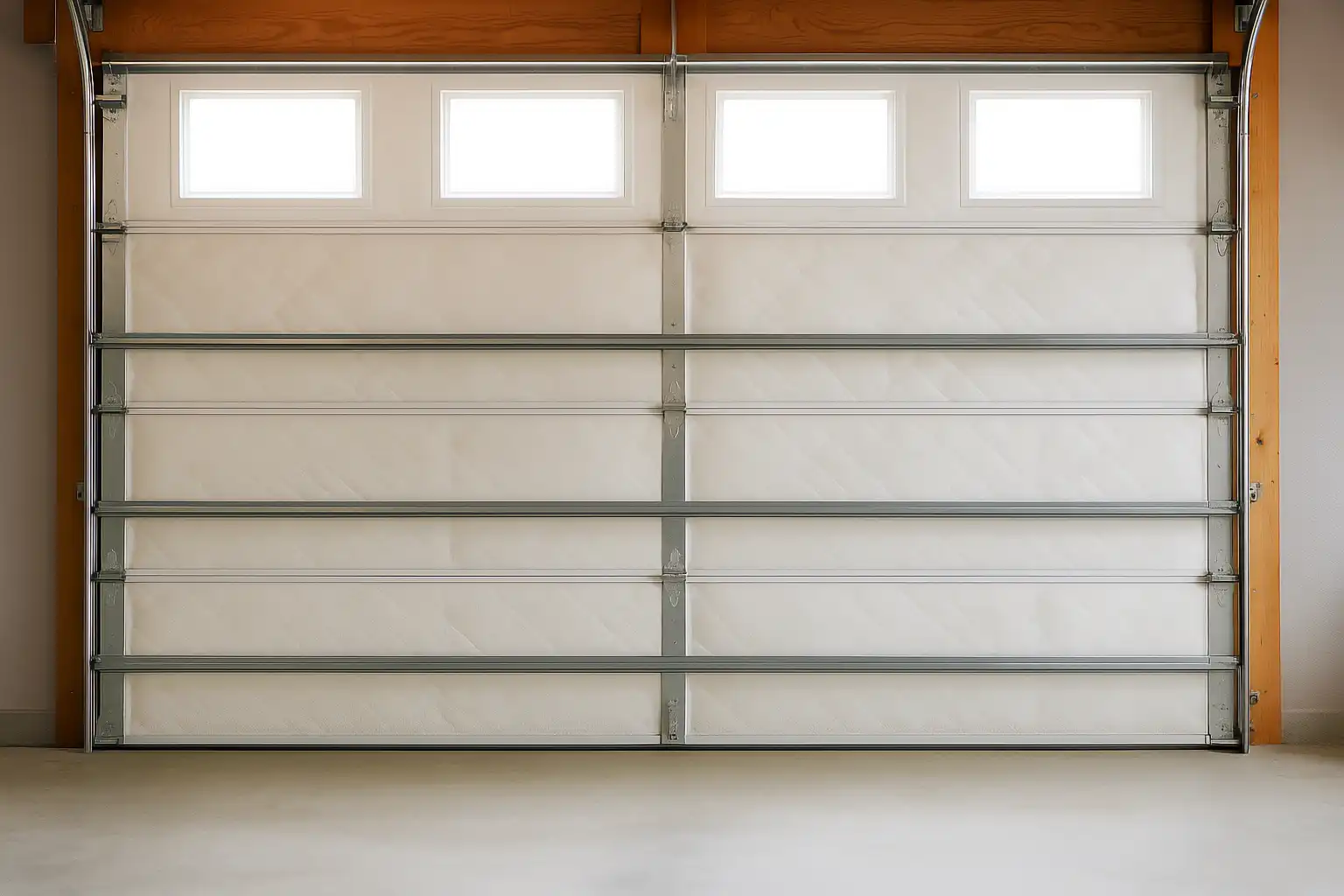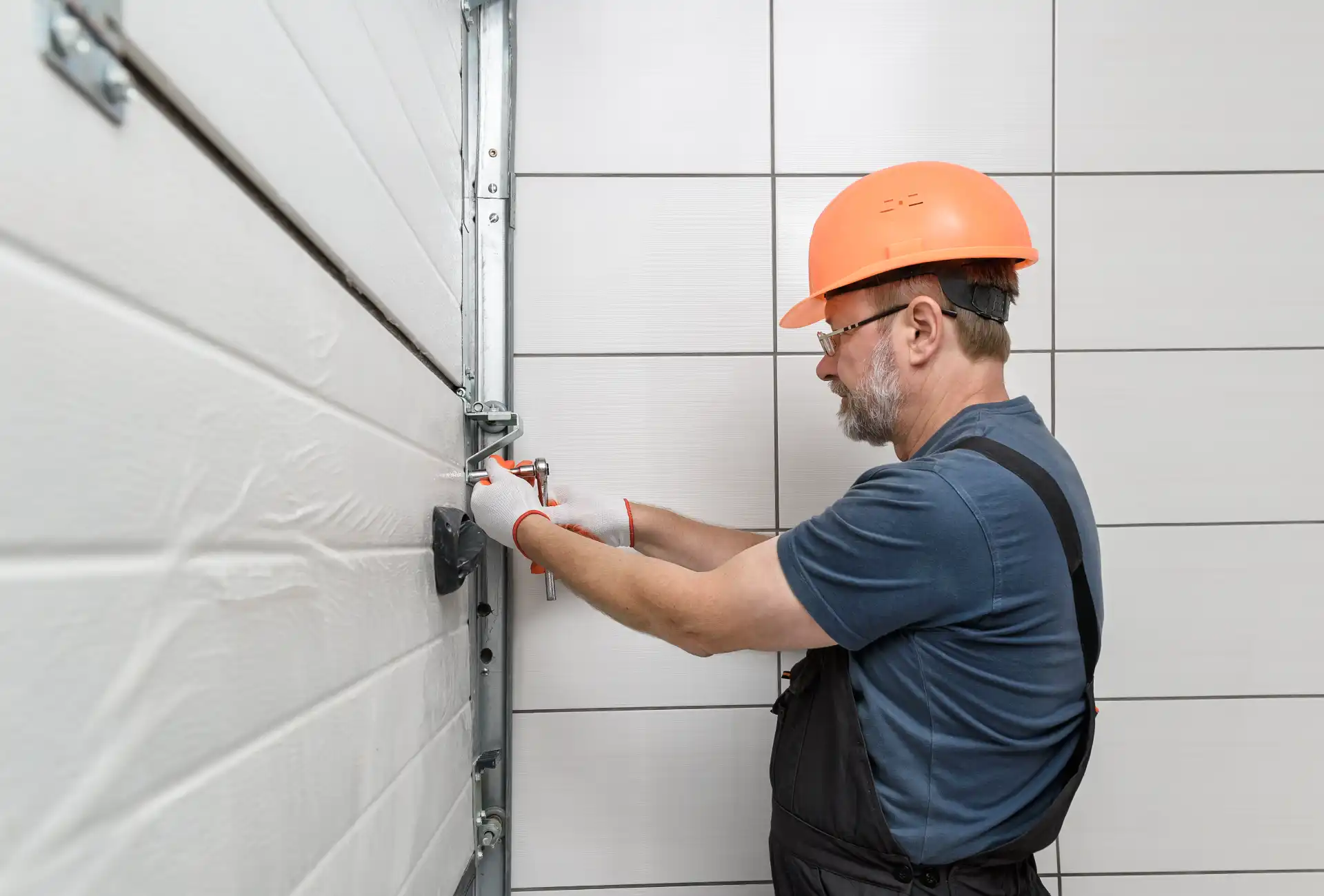
DIY Garage Door Insulation: Save Money & Energy Year-Round
Garage door insulation is an essential step for energy savings and improved comfort throughout the year. By insulating your garage door, you can maintain a stable indoor temperature, reduce heating and cooling costs, and enhance the overall comfort of your home.
Importance of garage door insulation for energy savings:
- Reduces heat loss in winter and heat gain in summer.
- Lowers utility bills by improving thermal efficiency.
Overview of DIY approach:
- Cost-effective solution compared to professional installations.
- Achievable with readily available materials and tools.
Impact on comfort and utility bills:
- Stabilizes the temperature inside the garage and adjacent spaces.
- Protects stored items from extreme temperatures.
- Contributes to a more energy-efficient home, reducing your carbon footprint.
Understanding Garage Door Insulation

What is Garage Door Insulation?
Garage door insulation refers to the process of adding insulating material to your garage door to improve its thermal efficiency. This prevents heat transfer between the inside and outside of the garage, enhancing comfort and reducing energy costs.
The Concept of R-Value
R-value is a measure of thermal resistance, indicating how well an insulation material can resist heat flow. Higher R-values provide better insulation, making it crucial to choose materials with appropriate R-values based on your garage type.
For instance:
- Detached, non-heated garages: R-value between 0 to 6
- Attached, non-heated garages: R-value of 7 to 9
- Heated garages: R-value from 10 to 13
- Garages with living spaces above: Minimum R-value of 14
How Insulation Improves Thermal Efficiency and Reduces Energy Costs
Insulating your garage door enhances thermal efficiency by:
- Reducing Heat Transfer: Proper insulation minimizes heat loss in winter and keeps heat out in summer. This stabilizes the indoor temperature.
- Lowering Energy Bills: With improved thermal efficiency, your heating and cooling systems work less, leading to reduced energy consumption and cost savings.
Investing in garage door insulation is a practical DIY project that significantly impacts energy savings and comfort throughout the year.
Choosing the Right Insulation Based on Garage Type

Selecting insulation with the correct R-value for your garage type plays a crucial role in energy savings and comfort. Matching insulation performance to your specific needs prevents wasted money on over- or under-insulating.
Garage Types & Recommended Insulation R-Values:
- Detached, Non-Heated Garages: These spaces typically store vehicles or equipment and don’t require high thermal protection. An R-value of 0 to 6 is sufficient, offering basic temperature moderation without excessive cost.
- Attached, Non-Heated Garages: Since these garages share at least one wall with your home, better insulation slows heat transfer. R-values of 7 to 9 help keep indoor temperatures stable and reduce demands on your home’s HVAC system.
- Heated Garages: If you use your garage as a workshop or have it integrated with your home’s heating system, heat loss becomes a major concern. Heated garage insulation should fall within an R-value range of 10 to 13 for efficient climate control.
- Garages With Living Spaces Above: Rooms above garages are highly vulnerable to temperature swings. To protect both the living area and stored items below, aim for an R-value of at least 14. This higher level blocks significant heat transfer between floors.
Matching insulation R-values to garage types doesn’t just lower energy costs—it also improves comfort in adjacent rooms and protects sensitive belongings. Choosing wisely ensures optimal year-round performance from your garage door insulation.
Popular Garage Door Insulation Materials
Choosing the right insulation material makes a dramatic difference in the effectiveness and longevity of your garage upgrade. Several options stand out for the “DIY Garage Door Insulation: Save Money & Energy Year-Round” list, each with specific strengths and drawbacks:
1. Fiberglass Insulation
Pros: Widely available, budget-friendly, and simple to cut or fit into most garage door panels.
Cons: Highly sensitive to moisture and humidity, which can lead to mold or reduced performance if not properly sealed.
2. Cellulose Insulation
Pros: Made from recycled plant fibers and treated for fire resistance, cellulose is an eco-friendly option that also helps with soundproofing.
Cons: Requires a finished wall or panel covering to stay in place; not usually the first choice for direct garage door application, but useful in wall cavities.
3. Rigid Foam Boards
Pros: Offers some of the highest R-values per inch, resulting in superior thermal efficiency. Lightweight with excellent resistance to moisture if properly installed.
Cons: Tricky to cut accurately around hardware, wiring, or piping; may require precise measuring and fitting.
4. Spray Foam Insulation
Pros: Delivers exceptional air sealing with high R-value performance. Expands to fill gaps and cracks, providing a tight thermal envelope.
Cons: DIY installation can be messy and requires protective gear. Harder to control during application compared to pre-cut boards or batts.
5. Reflective Insulation
Pros: Features layers of aluminum foil designed to reflect radiant heat, making it ideal for hot climates where solar gain is a concern.
Cons: Less effective as primary insulation in cold climates; best used as a supplementary layer.
Each of these materials plays a distinct role in boosting energy savings and comfort when insulating your garage door. Selecting the right one depends not only on climate and budget but also on your specific garage door type—a topic explored next.
Matching Insulation Materials to Garage Door Types
Steel garage doors inherently provide better insulation compared to wooden doors due to their denser structure. However, additional insulation can further enhance their thermal efficiency.
Recommended Materials for Steel Doors
- Fiberglass batts: These are cost-effective and easy to handle, making them a popular choice for steel doors. Their flexibility allows them to fit snugly into the panels.
- Rigid foam boards: Offering a high R-value, they are suitable for steel doors but require precise cutting and fitting.
- Spray foam insulation: Provides excellent coverage and high R-values, but can be challenging for DIY installations.
Recommended Materials for Wooden Frame-and-Panel Doors
Wooden garage doors typically have lower inherent insulation properties, necessitating careful material selection:
- Rigid foam boards: Ideal for wooden frame-and-panel doors due to their structural rigidity and high R-value. They can be cut to fit the individual panels perfectly.
- Reflective insulation: Works well in hot climates by reflecting radiant heat away from the door, though it may need support from additional materials.
Material Compatibility
Matching insulation materials to your garage door type ensures optimal energy efficiency and ease of installation. Always consider the specific properties of each material relative to the door type you have.
DIY Garage Door Insulation Kits and Tools
DIY insulation kits make garage door upgrades accessible for any homeowner. Most kits come with pre-cut panels sized to fit standard door sections, along with fasteners, tape, and adhesive strips to secure materials in place. You’ll typically need only a utility knife or heavy-duty scissors, a measuring tape, and a straight edge for trimming panels to custom sizes. Some kits also include gloves and simple installation tools for added safety. Using these kits streamlines the process—reducing guesswork, speeding up installation, and helping you achieve a tight fit that maximizes energy savings.
Step-by-Step Guide to Installing Garage Door Insulation Yourself

A successful DIY insulated garage door project starts with accurate prep and careful execution. Each step builds on the last for a snug, energy-efficient result. Here’s how to tackle the process:
1. Measure Door Panels Accurately
Use a rigid tape measure to record the width and height of each garage door panel. Note that panels may vary slightly in size—measure each one individually for best fit.
2. Cutting Insulation Materials
Transfer measurements onto your insulation material. Cut panels using a sharp utility knife and straightedge for clean, precise edges. If you’re using a kit, most panels will be pre-cut but may need minor trimming.
3. Attaching Panels Securely
Place each insulation panel into its corresponding section. Secure them using the provided clips or double-sided adhesive tape, pressing firmly for full contact. Proper attachment ensures no sagging or gaps.
4. Orientation Tips
Install vinyl-faced or reflective foil panels with the shiny side facing outward (toward the garage interior) to reflect radiant heat.
5. Sealing Edges
Apply caulk along the perimeter of each panel to seal any air leaks. Focus on corners and seams where drafts can sneak through.
6. Door Balance Check
After installation, test the garage door’s movement by manually lifting it halfway — it should stay in place. If not, adjust the spring tension or consult your owner’s manual for balance tips.
Taking these steps ensures that measuring and cutting insulation is done right, panels are snugly fitted, and your insulated door operates smoothly year-round.
Benefits of Insulating Your Garage Door Year-Round
1. Reduced Energy Bills
Insulated garage doors play a crucial role in lowering heating and cooling costs. By maintaining a consistent temperature inside the garage, your HVAC system doesn’t have to work as hard, resulting in noticeable energy savings.
2. Enhanced Temperature Stability
By providing an extra layer of protection against external temperatures, insulated doors ensure that your garage and adjacent spaces remain comfortable throughout the year. This stability is especially beneficial for garages with living spaces above.
3. Noise Reduction
An insulated garage door effectively dampens outside noise. This feature is particularly useful if your garage doubles as a workshop or recreational area where reduced sound disturbance is desirable.
4. Protection of Stored Items
Extreme temperatures can damage items stored in your garage. Insulation helps maintain a moderate internal climate, safeguarding tools, vehicles, and other possessions from temperature-related deterioration.
5. Increased Durability and Home Resale Value
Insulating your garage door not only enhances its durability by reducing wear and tear but also potentially increases the resale value of your home. Prospective buyers often view insulated garages as a valuable addition.
6. Environmental Benefits
Lowering energy consumption through effective insulation reduces your carbon footprint. This environmental benefit aligns with growing trends towards more sustainable living practices.
By addressing these points, insulating your garage door proves to be a practical investment for both immediate comfort and long-term financial and environmental benefits.
Maintenance Tips for Longevity and Effectiveness
To ensure your garage door insulation remains effective, incorporate these maintenance practices:
- Regular Inspections: Periodically check for damage or wear in the insulation material to address any issues promptly.
- Garage Door Balance: Maintaining proper balance in the garage door mechanism is crucial after adding weight from insulation. An imbalanced door can lead to operational issues and increased wear.
- Air Leaks: Address any air leaks or gaps over time by sealing edges with caulk or appropriate sealants to maintain thermal efficiency.
By following these insulating maintenance tips, you can prolong the lifespan of your garage door insulation and maximize its benefits.
Considerations Before Starting Your DIY Project
Before you begin your DIY Garage Door Insulation: Save Money & Energy Year-Round project, take time to evaluate these key factors:
- Climate considerations for insulation: Match the R-value and material type to your region’s temperature swings. Hotter climates benefit from reflective insulation, while colder areas need higher R-values for true thermal resistance.
- Budget planning DIY insulation: Compare upfront material costs with projected energy savings. While rigid foam and spray foam offer higher efficiency, they typically demand a bigger initial investment than fiberglass or basic kits.
- Safety precautions for fiberglass handling: Always wear gloves, long sleeves, eye protection, and a mask when cutting or installing fiberglass. Spray foam requires ventilation and strict adherence to manufacturer safety guidelines.
A smart approach at this stage ensures the rest of your installation goes smoothly and safely.
When to Consult a Professional
Not every garage door insulation project is suited for DIY. Certain scenarios warrant professional consultation for garage door insulation, such as:
- Complex Installations: Multi-layered doors, integrated windows, or custom-sized panels often require specialized handling and tools.
- Uncertainty About Materials: If you’re unsure which insulation type or R-value fits your needs, expert advice for installation help ensures you don’t waste money or compromise effectiveness.
Professional installers offer precise, code-compliant work that protects your investment. Their expertise minimizes safety risks, addresses structural challenges, and guarantees optimal thermal performance with lasting results.
Conclusion
DIY Garage Door Insulation: Save Money & Energy Year-Round
Insulating your garage door is a cost-effective project that brings significant year-round energy savings and comfort improvements. By choosing the right materials and following proper installation techniques, you can:
- Reduce heating and cooling costs
- Enhance temperature stability in your home
- Protect stored items from extreme temperatures
- Increase the durability of your garage door
- Boost your home’s resale value
Embarking on this DIY project contributes to long-term savings benefits and environmental sustainability by reducing your carbon footprint. Taking the initiative to insulate your garage door not only enhances your living space but also ensures financial savings through improved thermal efficiency.
Start your DIY garage door insulation today and experience the benefits throughout every season.
